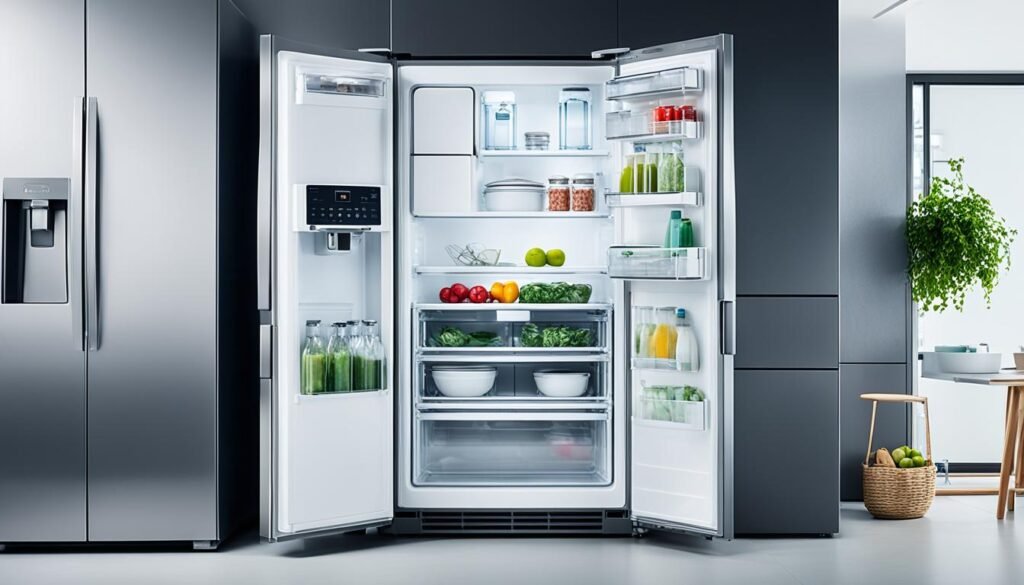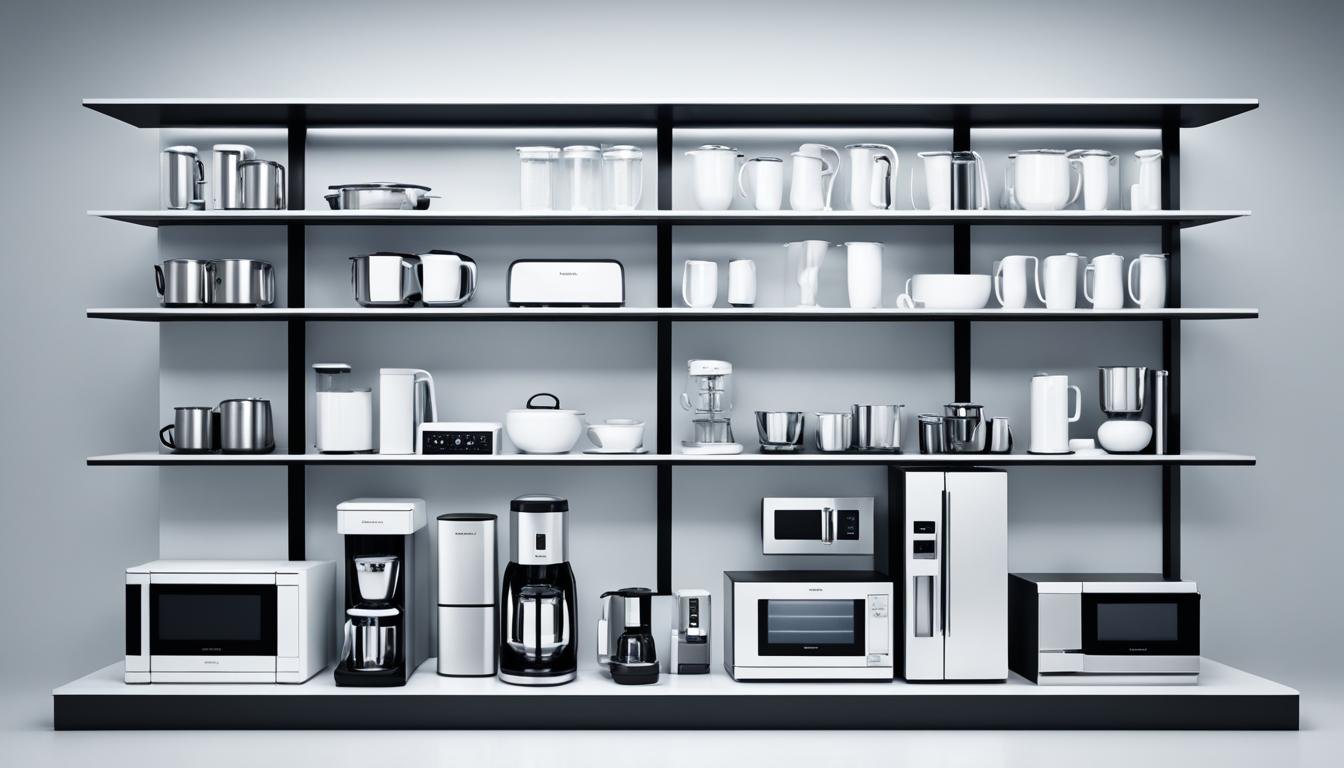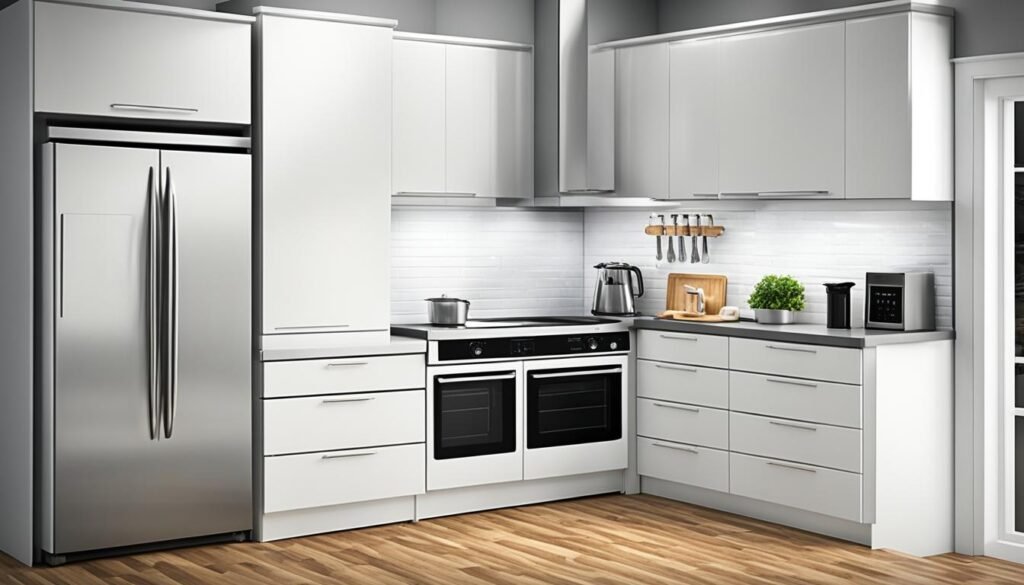Home appliances cover devices that help with tasks like cooking, cleaning, and keeping food fresh. There are three main categories: major appliances, small appliances, and consumer electronics.
Major appliances are big items such as fridges, washing machines, and dishwashers. Small appliances are things like toasters, blenders, and coffee makers. Consumer electronics cover items like TVs and computers.
These gadgets have changed how we live. We used to rely more on full-time help. But as that changed, we looked for ways to make our homes chores easier.
The industry around home appliances has gotten bigger and more advanced. New tech and a focus on saving energy keep inspiring innovation.
Key Takeaways
- Home appliances are devices used in the home to perform various tasks, including cooking, cleaning, and food preservation.
- Home appliances can be categorized into three main groups: major appliances (white goods), small appliances, and consumer electronics (brown goods).
- The home appliance industry has seen significant growth and consolidation, with advancements in technology and energy efficiency driving innovation.
- Major appliances include refrigerators, washing machines, and dishwashers, while small appliances include toasters, blenders, and coffee makers.
- Consumer electronics include TVs, computers, and other entertainment and communication devices.
Introduction to Home Appliances
Home appliances help with daily tasks at home. They make cooking, cleaning, and storing food easier. This allows people to enjoy their free time more. Home appliances cover everything from big machines like refrigerators to small ones like coffee makers.
Definition and Purpose
Home appliances are electrical devices for household work. They include cleaners and cookers. These tools make life easier and save time. They bring comfort and convenience to our daily lives.
There are both big and small home appliances. Major ones are air conditioners and washing machines. Small ones are juicers and toasters. TVs and home theaters are also in this group.
| Category | Examples |
|---|---|
| Major Appliances (White Goods) | Air conditioners, dishwashers, clothes dryers, freezers, refrigerators, kitchen stoves, washing machines |
| Small Appliances | Juicers, electric mixers, coffee makers, blenders, toasters |
| Consumer Electronics (Brown Goods) | Televisions, DVD players, home theater systems |
In the 21st century, we rely more on these tools for comfort. Manufacturers are creating smart, sustainable appliances. They aim to meet our changing needs.

Major Appliances: The White Goods
Major appliances, known as “white goods,” are big items used at home. They are crucial for a modern lifestyle. These items include air conditioners, dishwashers, and washing machines. They were once all painted white, leading to the term “white goods.”
Today, they come in many colors. These big machines are key in both the kitchen and laundry room, making life easier.
New major appliances focus a lot on saving energy. For example, modern energy-efficient refrigerators use 40% less energy than ones in 2001. If everyone in Europe swapped old appliances for new ones, they would save 20 billion kWh of electricity each year. This would also cut CO2 emissions by almost 18 billion kg.
A similar change in the US would mean saving 17 billion kWh of power. It would also cut down CO2 by 27,000,000,000 pounds. According to McKinsey & Company, replacing old appliances helps the most in reducing greenhouse gases globally.
New tech is letting appliances manage their power better. For instance, appliances can shut off or slow down when they’re not being used. This saves energy. Also, using gallium nitride transistors in new gadgets makes them use less power. But, they might cost more.
| Appliance | Amperage (A) | Wattage (W) |
|---|---|---|
| Laptop | Less than 0.5 | Up to 100 |
| Mobile Phone Charger | Less than 0.5 | Up to 75 |
| Electric Blanket | Up to 1.3 | Up to 300 |
| Kettle | Up to 13 | 2200 to 3000 |
| Washing Machine | 10 | 2200 |
| Hair Dryer | 10 | 2200 |
| Immersion Blender | 1.6 | 350 |
| Dishwasher | 10 | 2200 |
| Toaster | 9.0 | 2000 |
| Portable Air Conditioner | 9.3 | 2000 |
| Patio Heater | Up to 13 | 1200 to 3000 |
| Slow Cooker | 0.5 to 1.1 | Up to 250 |
| Toothbrush Charger | Less than 0.5 | Up to 2.5 |
This table compares the power use of different appliances. It highlights how much power big machines like washing machines need. Knowing this can guide people to make energy-efficient choices. It can also help them manage their home’s power better.

“Replacing old appliances is one of the most efficient global measures to reduce greenhouse gas emissions.”
– McKinsey & Company
Home Appliance Categories
There are three main types of home appliances: major (white goods), small, and consumer electronics (brown goods). They each have unique functions. These categories have seen big technological changes, making life easier.
Major Appliances (White Goods)
Major appliances are big and do key home tasks. This group includes fridges, washers, dishwashers, ovens, and air conditioners. They might sit in a spot or be movable. They are key for a comfy and smoothly running home.
Small Appliances
Small appliances are small and do specialized tasks. They have things like blenders, coffee makers, toasters, and vacuum cleaners. These items make life more convenient and meet specific home needs.
Consumer Electronics (Brown Goods)
Consumer electronics are for fun and staying connected. This group has TVs, computers, speakers, game systems, and phones. They offer entertainment, ways to connect, and easy access to info in today’s digital world.
All these types of appliances have evolved with technology. They make our lives easier, more efficient, and fun at home.
| Appliance Category | Key Features | Examples |
|---|---|---|
| Major Appliances (White Goods) | Large, heavy-duty household appliances for essential tasks | Refrigerators, washing machines, dishwashers, ovens, air conditioners |
| Small Appliances | Compact, portable electrical devices for specialized functions | Blenders, coffee makers, toasters, irons, vacuum cleaners, kitchen accessories |
| Consumer Electronics (Brown Goods) | Entertainment and communication devices for leisure and connectivity | Televisions, computers, sound systems, gaming consoles, mobile devices |
Safety Standards and Regulations
To keep us safe, there are strong rules and guidelines for making sure our household appliances are safe. These come from the International Electrotechnical Commission’s IEC 61140 standard. It guides experts on making standards for electrical items, including appliances.
Appliances are split into groups by how they are insulated and grounded. Class I Appliances have basic insulation and a ground connection. Class II Appliances use double or reinforced insulation without a ground connection. Then, Class III Appliances work on Extra-Low Voltage (SELV) and don’t need a ground connection.
Before appliances hit the shelves, they must pass Portable Appliance Testing (PAT). This makes sure they are safe for us to use. It safeguards us and animals from dangers like electric shocks. Following these safety rules is key for using appliances safely and responsibly.
| Appliance Class | Description | Example Appliances |
|---|---|---|
| Class I | Rely on basic insulation and a protective earthing connection | Refrigerators, washing machines, electric ovens |
| Class II | Have double or reinforced insulation without a protective earthing connection | Televisions, microwaves, toasters |
| Class III | Operate on Extra-Low Voltage (SELV) and do not require protective earthing | Cordless power tools, low-voltage chargers |
The IEC 61140 standard gives a solid base for creating safety rules for home appliances. This system ensures that appliances meet strict Appliance Safety Standards and enables consumers to use their items safely.
Technological Advancements and Trends
The world of home appliances is changing fast, thanks to new tech. The industry is now into Home Automation and Internet-Connected Appliances. This changes how we use and control our devices at home.
Integrating Smart Home tech into appliances is a huge trend. Manufacturers add tech to connect and control appliances from your phone. This lets you manage your home’s devices from anywhere, making life easier and more Energy Management.
Home Automation and Internet Connectivity
Home Automation is reshaping the home appliance world. Now appliances have smart features like sensors and Wi-Fi. They can talk to each other and you through apps or voice. This brings amazing changes like:
- Changing settings, getting alerts, and fixing problems from far away.
- Automating how appliances work to save energy and money.
- Working smoothly with other smart home products.
- Fixing issues before they cause big problems.
These trends make our lives better and help the planet by saving energy. It means we can control energy use more effectively and be greener.
Advances in home appliances tech are making our homes better. The Smart Home movement is picking up. Soon, your devices will fit your life perfectly, making things more convenient, efficient, and letting you control your home’s Energy Management better.
Conclusion
Home appliances are now key in American homes, making life easier. Major appliances help with cooking, cleaning, and keeping our homes comfortable. Smaller gadgets enhance our lives further, changing a lot as time goes on.
To keep us safe, there are rules and guidelines for using these home appliances. Thanks to technological advancements like home automation and internet connectivity, appliances are getting smarter. This means more innovation and better solutions for our needs.
Thinking about upgrading your house? Knowing the latest trends and options is key. With the right choices, you can make your home more convenient, efficient, and integrated. This lasts and improves your lifestyle for the long run.
FAQ
What are the main categories of home appliances?
The main types are major appliances (like fridges and ovens), small appliances, and consumer electronics (such as TVs and cameras).
What are some examples of major appliances?
Air conditioners, dishwashers, and clothes dryers are a few examples. You can also include refrigerators, stoves, and washing machines in this list.
What is the purpose of home appliances?
They make our daily chores easier and faster, giving us more free time. For example, they help cook, clean, and keep our food fresh.
What safety standards and regulations are in place for home appliances?
Organizations like the IEC set safety rules for home appliances. These include rules on insulation and grounding. All appliances go through tests to check they’re safe to use.
How are home appliances evolving with technological advancements?
Now, appliances can connect to the internet and work with smart home setups. This lets us control them from far away and be more energy-efficient. It all fits into the idea of the IoT and smart homes.
Source Links
- https://en.wikipedia.org/wiki/Home_appliance
- https://kids.britannica.com/students/article/home-appliance/274927
- https://structuretech.com/gas-appliance-categories/
- https://www.vedantu.com/english/home-appliances-names
- https://www.slim.it/en/blog/domestic-appliance-and-home-appliance-what-are-the-trends
- https://business.amazon.in/en/discover-more/blog/home-appliances-list
- https://en.wikipedia.org/wiki/Major_appliance
- https://www.electricalsafetyfirst.org.uk/guidance/safety-around-the-home/home-appliances-ratings/
- https://home.howstuffworks.com/10-appliances.htm
- https://lifeyourway.net/types-of-household-appliances-and-their-advantages/
- https://www.intertek.com/appliances/iec-60335-1/
- https://www.consumerproductsafety.gov.sg/consumers/choose-safer-products/look-for-the-safety-mark/
- https://www.ul.com/services/iec-60335-1-standard-safety-household-and-similar-electrical-appliances
- https://cwservicesinc.com/embracing-the-future-exploring-appliance-technology-trends/
- https://www.podium.com/article/appliance-industry-trends/
- https://www.linkedin.com/pulse/decoding-home-appliance-market-deep-dive-latest-trends-segmentation-1m2te
- https://www.structuretech.com/gas-appliance-categories/
- https://www.haveignition.com/industry-guides/go-to-market-strategy-for-home-appliances
- https://www.gseice.com/blogs/knowledge/commercial-household-appliance-differences-kitchen




